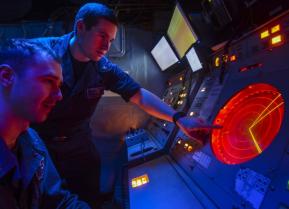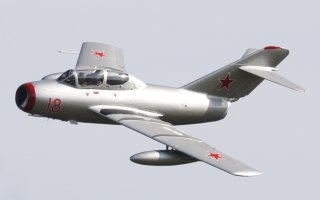The Time U.S. Navy Jets Battled Russian Jets in a Siberian Snow Storm
Only in the 1990s did Russia would declassify its own account of the air battle near Vladivostok.
Here's What You Need to Know: Soviet fighters shot down numerous American aircraft throughout the 1950s.
On the afternoon of November 18, 1952 four sleek jets painted an inky navy blue soared off the deck of the carrier USS Oriskany into a swirling Siberian snow storm gusting over the Sea of Japan. The carrier was part of Task Force 77, a fleet of twenty-five ships which included three carriers used to launch daily airstrikes on North Korean bridges and logistics during the Korean War. Earlier that day, its warplanes had struck the logistical base at Hoeryong, used as a gathering point for supplies received from China and the Soviet Union a short distance across the border.
The four F9F-5 Panther jets were braving flurrying snow, cloud cover down to 500 feet and visibility not exceeding a few miles, to fly a Combat Air Patrol (CAP). The fleet’s air search radars could only reliably detect aircraft under ranges of 100 miles—and Soviet Il-28 jet bombers that could cover that distance in a few minutes had been photographed nearby. Though no direct air attacks on the fleet had been attempted by Soviet or Chinese jets, it was vital to maintain the CAP to guard against a surprise attack.
The Panther flight was flying a patrol pattern at 16,000 feet when they received a report—bogeys detected just eighty-three miles north of their position, heading from the direction of Vladivostok.
The four aircraft from Navy squadron VF-781 assumed an intercept course. Sure enough, they spotted the vapor trails of seven Soviet jets flying high above them at 40,000 feet and the silvery glint of their bare metal fuselages. These were not Il-28 bombers, but MiG-15 fighter jets that could outrun even the late model F9F-5 Panther by seventy miles per hour.
At the same moment, the fuel pump of flight leader Lt. Claire Elwood aircraft began to malfunction. He was called back to the carrier, and his wingman assigned to cover for him. The Panthers of Lt. Royce Williams and Lt. Jg. David Rowland were left to face off against seven superior Soviet fighters.
What happened next remained a secret for the next forty years, and would only be fully detailed in 2013 when Royce was interviewed by Thomas McKelvey for Flight Journal magazine.
Since November 1950, Soviet MiG-15 units had been battling American fighters over Korea. However, they had always been deployed from Chinese bases under the pretense of being Chinese or North Korean units. Officially Soviet forces were not party to the war, and Washington did not seek to dispel this fiction for fear of further escalating the Korean conflict it was seeking to bring to a close.
Soviet fighters did shoot down numerous American reconnaissance planes throughout the 1950s, and U.S. fights did stray over the border and attack Soviet airfields on a few occasions. But generally, a fighter unit based on Soviet territory was not expected to join in the fighting.
Indeed, when the American pilots first approached the Soviet fighters at 16,000 feet, the higher-flying jets appeared to turn back for home. Then they split into two groups, and a four-ship flight peeled around and dove at the U.S. fighters from the ten o’clock position in line abreast formation, spitting cannon shells.
Royce turned hard and managed to fall behind the last MiG and set it aflame with a burst of his cannons. However, the guns of his wing mate Rowland’s Panther had jammed. Wishing to record Royce’s kill for posterity with his gun camera, Rowland stayed on the MiG’s tail as it splashed into the ocean.
Williams was left in a swirling dogfight with the six remaining Soviet fighters that lasted twenty minutes. The swept-wing MiG-15 was faster and more maneuverable than the straight-wing American naval jet. However, the F9F Panther was a legendarily robust design, and also a better gun platform with its four rapid-firing 20mm cannons. The MiGs had two 23mm cannons and a very hard-hitting 37mm gun, but these were slower firing, lower velocity weapons that were less accurate verses nimble fighters.
Williams kept his Panther at full throttle and kept turning inwards of attacking MiGs, firing short bursts from his cannons. The twenty-six-year-old from Minnesota had received high marks during gunnery training. In rapid succession he managed to rake first the lead fighter and its wingmate with 20mm shells while coming out of turn, causing both to burst into flames, and then heavily damaged a fourth MiG.
However, a MiG pounced on Royce’s tail and shredded his plane with cannon fire, shooting up his wing and into his engine, disabling critical hydraulics. The Panther’s rudder and flaps became unresponsive and his ailerons only partially effective. The Panther pilot was reduced to making evasive maneuvers with his only fully functional control surface, the horizontal elevators in the tail.
The Navy pilot dove for the clouds far below, but a MiG-15 followed him down, its cannons flashing. Royce used his elevators to bob his jet up and down as his cannon shells zipped passed him from above and below. Finally, his wingman charged up towards the Soviet fighter, which broke off—fortunately, as Rowland’s guns remained jammed! But Royce was only barely able to pull his shot-up jet out of its dive, emerging from the clouds only 400 feet above the ocean—too low to survive an ejection.
Instead, Williams limped his Panther back to the Oriskany, even braving anti-aircraft fire from U.S. ships which misidentified his passing aircraft. Not desiring to ditch his plane in the deadly cold waters of the Sea of Japan, he instead attempted a high-speed landing at 170 miles per hour, as his Panther could no longer handle safely at minimum speed. The Oriskany’s skipper helpfully angled the ship to the wind and Royce’s successfully snagged the tail hook of his half-destroyed Panther on the third wire of the carrier. Maintenance personnel counted more than 263 shell holes cratering the badly damaged plane, which was unceremoniously photographed, stripped of valuable parts and pitched over the deck.
The Navy pilot would learn that an NSA surveillance unit on the cruiser USS Helena had been spying on the Soviet radio chatter; it had both warned of the approaching MiGs and had learned that three had been shot down, and a damaged fourth jet flown by Cpt. Viktor Belyakov had fatally crash landed in the Soviet Union. Royce had achieved an unheard-of feat—in one thirty-five-minute skirmish he either equaled or exceeded all the MiGs shot down by other Panther pilots throughout the Korean War.
An admiral warned Williams to keep quiet about his extraordinary accomplishment—it was important that the United States and the Soviet Union remain officially not at war, and that the Soviets not realize they had been spied upon by the NSA unit. But Royce’s actions did not go entirely unrecognized. A month later, he was summoned to Seoul for drinks with President Elect Dwight Eisenhower—prepared by his son John, no less!—who wanted a briefing on the progress of the air war. According to Royce, he would forever regret passing on the president’s recommendation of scotch in favor of his habitual bourbon-on-water.
Only in the 1990s did Russia would declassify its own account of the air battle near Vladivostok and reveal the names of the four Soviet pilots fallen in action, including Captain Valandov and Lieutenants Palomkhin and Tarshinov. Only then did Williams consider himself released from his pledge to secrecy.
The Panther on MiG skirmish over Vladivostok was the last occasion in which a U.S. fighter plane shot down a nominally Russian fighter, but not the last aerial engagement between Soviet and U.S. military forces. In 1953, an F-84 Thunderjet was shot down by a Czech MiG-15 over Bohemia, and between that year and 1970 more than a dozen U.S. transport and reconnaissance planes would be destroyed by Soviet fighters and missiles.
Sébastien Roblin holds a master’s degree in conflict resolution from Georgetown University and served as a university instructor for the Peace Corps in China. He has also worked in education, editing and refugee resettlement in France and the United States. He currently writes on security and military history for War Is Boring.
This article first appeared in 2017.
Image: Wikimedia Commons


